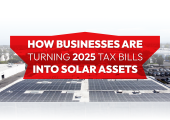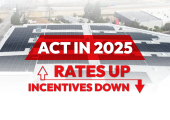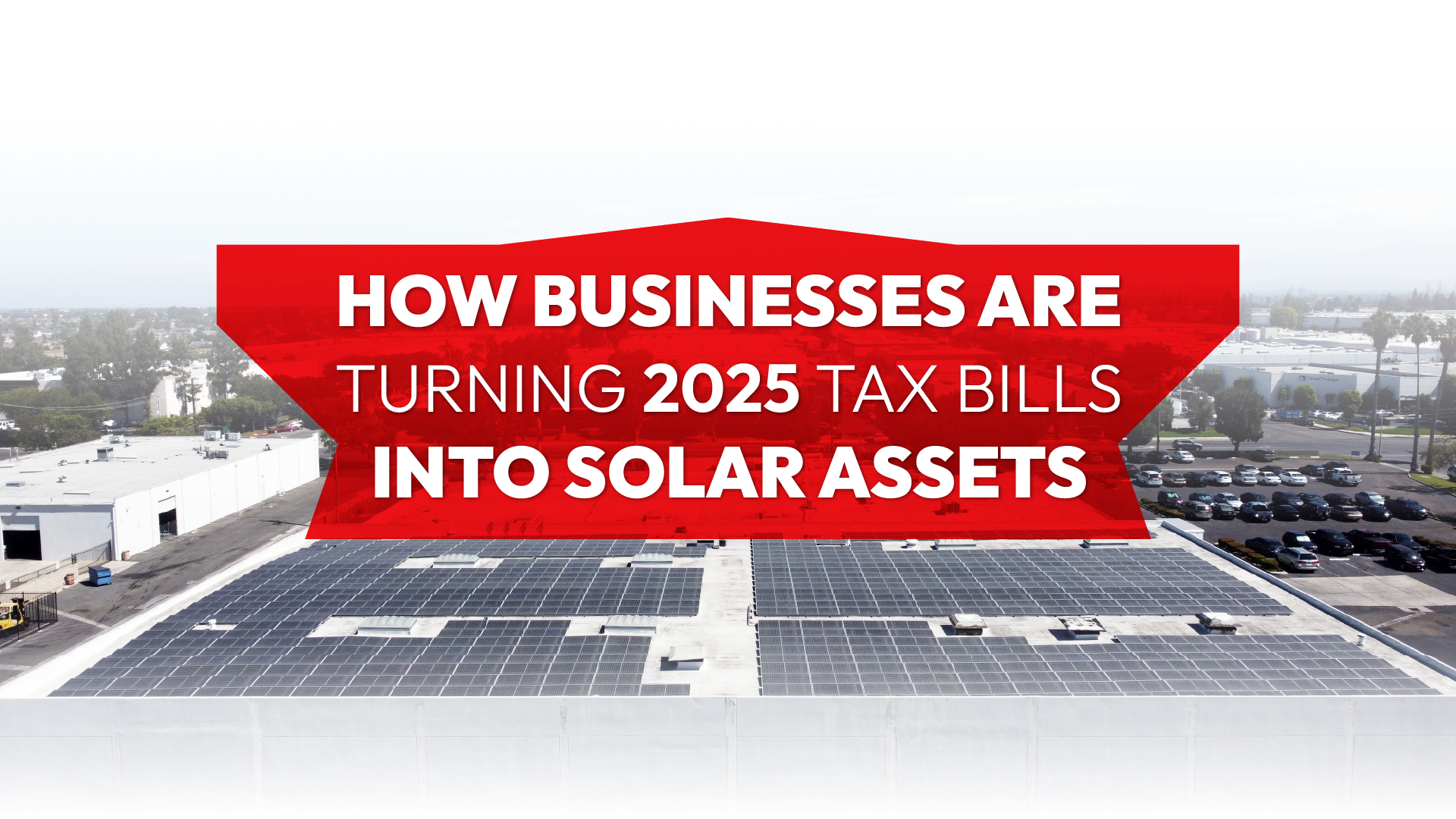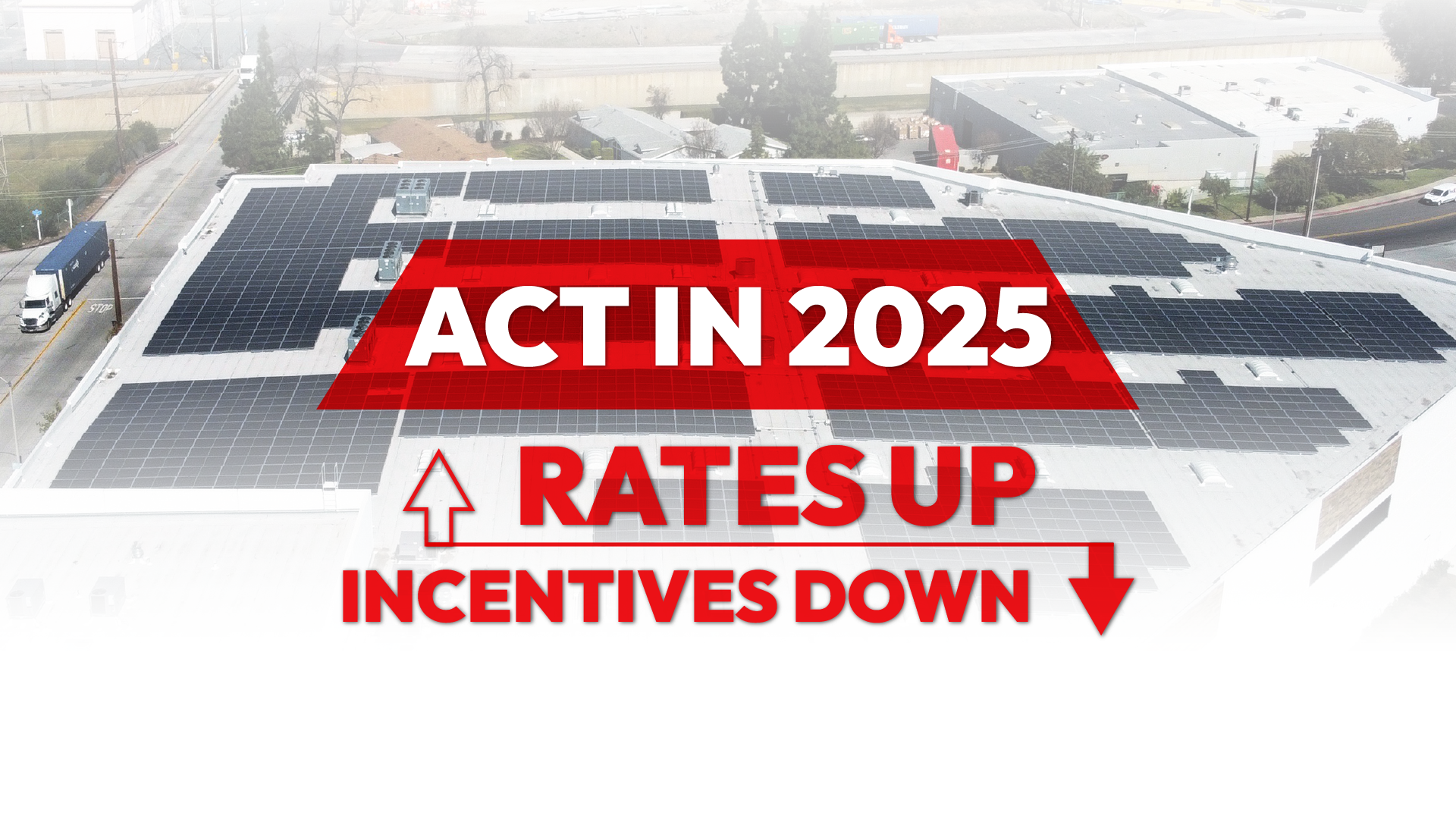Wondering when the solar tax credit ends?
For millions of homeowners, the 30% Residential Clean Energy Credit (IRC §25D) now terminates for expenditures after Dec. 31, 2025, under the new federal law (“One Big Beautiful Bill,” or OBBB).
For businesses, nonprofits, and public entities, the Investment Tax Credit is still available—but has shifted to the technology-neutral Clean Electricity Investment Credit (IRC §48E) for facilities and energy storage placed in service after Dec. 31, 2024. However, new FEOC sourcing rules beginning in 2026 will make compliant equipment harder to source, so 2025 is the practical cutoff for most projects
The urgency is real. Businesses, nonprofits, municipal entities, and homeowners need to plan well ahead to meet deadlines, handle engineering and permitting timelines, and ensure all proper documentation is in place.
So, what exactly is changing—and what does it mean for California businesses and residents? Let’s break it down.
Understanding the Solar ITC Expiration
The Investment Tax Credit (ITC)—also known as the federal solar tax credit—allows eligible taxpayers to deduct 30% of qualified expenses for solar panel installation, battery storage expenditures, contractor labor, developer fees, engineering services, inspection fees, sales taxes, and more.
Key details about the solar ITC expiration:
- Residential solar: The 30% Residential Clean Energy Credit (§25D) ends for expenditures made after Dec. 31, 2025. This is the last date homeowners can capture the full value.
- Commercial solar and storage: Beginning in 2025, these projects shift into the §48E Clean Electricity Investment Credit. The base rate under §48E is 6%, but projects can reach 30% with prevailing wage, domestic content, and energy community siting bonuses.
- True federal deadline: While the IRS construction-start deadline is July 4, 2026, the effective cutoff for most projects is Dec. 31, 2025, because FEOC sourcing restrictions begin in 2026 and will raise costs or disqualify equipment.
So why does Dec. 31, 2025 matter?
That’s when FEOC restrictions begin to bite, making compliant equipment sourcing and financing much harder. In practice, this creates an “effective deadline” for businesses and homeowners who want to avoid supply chain bottlenecks, higher costs, and eligibility risks.
In short: Residential projects must be completed by Dec. 31, 2025, and commercial projects should aim to start before that date to lock in equipment and incentives—well ahead of the ultimate July 4, 2026 IRS cutoff.
Why California Businesses Must Move Now
Understanding the rule is one thing—but in California, the stakes are even higher.
California remains one of the largest solar markets in the U.S. — in 2024, the state’s cumulative installed solar capacity exceeded ~46,874 MW, enough to power 13.9 million homes, and solar already provides approximately 28 % of California’s electricity generation.
Also, as of August 2024, California accounted for about 21.0 GW of utility-scale solar capacity—one of the largest shares in the U.S. In 2024, U.S. utility-scale solar installations again broke records, with over 32 GW added (and solar accounting for roughly 66 % of all new electricity capacity additions).
Between California incentives, community choice aggregation programs, and aggressive state-level goals (e.g., 100 % clean electricity by 2045 under SB 100), the market dynamics favor early action. But state-level incentives cannot substitute the 30 % federal benefit before the move to new rules post-2025.
Risks of waiting include:
- Rising solar equipment and labor costs due to mounting demand
- Strained engineering and permitting capacity
- Overbooked contractors delaying installations
- Utility interconnection queues lengthening
- Lost access to battery incentive programs or stackable credits
So, even though the federal construction-start deadline extends into 2026, California projects face real risk if they wait—because after 2025, FEOC restrictions, interconnection bottlenecks, and equipment sourcing challenges will make timely completion far more difficult.
Solar + Battery Storage = Long-Term Energy Security
One of the most transformative changes in the solar industry has been the inclusion of battery storage systems under the residential and commercial federal tax credits. Under the Residential Clean Energy Credit (for homes), battery storage technology with a capacity of at least 3 kWh qualifies beginning in 2023. For commercial projects, §48E also covers energy storage placed in service (stand-alone or paired).
Thanks to the Inflation Reduction Act and updates to federal law, businesses can now pair solar panel installation with battery storage systems to create resilient, grid-independent energy solutions.
Benefits of battery storage integration include:
- Reducing energy costs during peak demand periods via demand charge reduction
- Providing backup power during outages or grid disturbances
- Increasing reliability and energy security
- Capturing federal tax credits and state/utility battery rebates
- Enabling advanced energy management and optimization.
For commercial facilities, combining solar and storage not only lowers operational electricity expenses but also enhances predictability and access to new revenue streams (e.g. grid services).
But eligibility depends on meeting capacity and placement requirements — be sure to consult tax and engineering advisors early in the design process.
Eligibility Criteria: Who Can Claim the Credit?
The ITC is not automatic—you must meet strict eligibility criteria. Key considerations include:
- Eligibility requirements: Projects must meet engineering requirements, comply with federal incentive rules (such as prevailing wage/apprenticeship rules), and be placed into service by the relevant IRS deadlines.
- Qualified production property: Equipment must qualify under Section 48 of the Internal Revenue Code as energy-generating or storage property.
- Qualified expenses: Includes installation costs, labor costs, developer fees, sales taxes, inspection fees, inverters, racking, wiring, and (for systems ≤5 MW) certain interconnection property costs.
- Detailed records: You must maintain documentation of engineering designs, installation progress, inspection logs, change orders, interconnection applications, and cost breakdown by component.
- Tax situation: Your tax liability must be large enough to absorb the credit (the ITC is non-refundable but can often be carried forward).
Because the rules are technical, working with a licensed tax professional or tax provider is the safest way to ensure compliance and maximize your return. Once eligibility is established, the next step is securing the right financing and support tools.
Financing, Incentives & Support Tools
With the 30% residential credit ending after 2025 and commercial projects facing FEOC-related challenges beginning in 2026, planning your project’s financing strategy has never been more important. Businesses and solar customers have a range of tools available:
- Solar loans/debt financing tailored for commercial and industrial solar projects (often with 5–10 year terms).
- Power Purchase Agreements (PPAs) or leases, where a third party owns the system and sells power or leases capacity (though for PPAs, the owner must be the one to claim the credit).
- Utility rebates/incentive programs in California (e.g. local rebates by utility or state programs)
- Cost and Savings Calculators to model IRR (internal rate of return), payback period, net present value, and compare financing options
- Solar marketplace listings or competitive bidding platforms to source quotes from vetted EPCs
These tools, along with state and local incentives, can help reduce upfront cost burden and improve project economics. But careful preparation is key — and timing matters.
Step Checklist for Businesses
Now you might be wondering what your business should do first?
Follow a clear step guide that ensures eligibility before the tax credit deadline approaches:
- Conduct a solar feasibility analysis: With solar/engineering professionals, assess rooftop or ground area, structural capacity, shade analysis, irradiance, panel layout, and system sizing.
- Select reputable contractors: Review installer credentials, past performance, warranties, and financial strength (especially for commercial installers).
- File the interconnection application early: Submit to the utility months in advance; delays are common.
- Document installation progress meticulously: Record daily/weekly logs, change orders, inspector sign-offs, and cost breakdowns.
- Consult a tax professional specializing in energy credits: This ensures you structure the project (cost allocations, bonus credits, carry-forward options) properly.
- Anticipate supply chain / logistic delays: Order long-lead items early (modules, inverters, transformers) and plan buffer time for inspection scheduling or permit delays.
- Track and compare financing options: Monitor loan rates, terms, PPA proposals, and incentives to align with cashflow needs and project timeline.
Following this checklist increases the likelihood of qualifying and maximizing your benefit. Ultimately, everything comes down to the timeline—and the clock is ticking.
Additional Context / Risk Factors
Even with strong federal and California incentives in place, project success hinges on careful planning and risk management. Several external factors could affect your ability to capture the full value of the solar tax credit before it phases down:
- Supply chain delays – Long lead times for modules, inverters, and transformers can push projects past the deadline.
- Permitting & interconnection – Utility queues and inspection rescheduling often add months to timelines.
- Policy changes – New domestic content and FEOC rules under OBBB/IRA raise compliance risks if documentation isn’t precise.
- Rising costs – Surging demand ahead of 2025 is likely to increase labor and equipment prices.
- Financing uncertainty – Interest rates and PPA terms can shift quickly, limiting last-minute options.
The takeaway: the sooner you start, the less risk you face. Working with experienced EPCs and tax professionals helps secure credits and avoid costly delays.
Don’t Miss the Deadline
Whether you’re an average homeowner, a commercial developer, or part of a nonprofit organization, the solar ITC expiration represents the last chance to save thousands in incentives on solar energy investment.
By acting now, you can secure:
- Solar savings on installation costs
- Battery incentive programs that cover battery systems
- Long-term energy savings on electricity costs
- Protection against policy shifts and solar tax credit changes
Waiting could mean losing one of the most powerful financial incentives in America’s history of clean energy projects.
Partner with Revel Energy Before Time Runs Out
Here, at Revel Energy, we specialize in commercial solar projects across California, helping businesses cut electricity costs, stabilize against rising utility rates, and secure every available solar incentive.
Don’t wait until the solar tax credit deadline approaches. Visit our website today to schedule a consultation and start your project while the Commercial Solar Tax Credit is still available.
FAQ
- When does the solar tax credit end?
For homeowners, the Residential Clean Energy Credit ends Dec. 31, 2025. For businesses, nonprofits, and public entities, the Investment Tax Credit continues under §48E, but projects must begin construction before July 4, 2026 to secure the full 30% benefit. After 2025, FEOC sourcing rules make qualifying equipment much harder, creating an effective urgency for both residential and commercial projects.
- What does the solar tax credit ending in 2025 mean for businesses?
It means losing access to one of the most effective tools for reducing solar costs, improving energy reduction, and achieving long-term energy savings. For businesses with commercial projects, waiting could mean facing tighter budgets and higher electricity costs.
- How does the California solar tax credit expiration impact residential solar?
While California offers rebate programs and other solar incentives, the federal expiration will apply nationwide. This means residential solar tax credit benefits will vanish, leaving only smaller state-level programs.
- What is included in the solar ITC?
The ITC covers solar panel installation, labor costs, battery storage expenditures, engineering services, sales taxes, inspection fees, and other eligible expenses. Both residential solar and commercial projects can qualify.
- Are battery storage systems eligible?
Yes. Battery storage equipment, battery storage projects, and battery storage installation are fully eligible under the Inflation Reduction Act, making them one of the most valuable add-ons for businesses looking to secure thousands in incentives.
- Who are the ideal candidates for solar before the deadline?
Businesses with high electric rates: homeowners with rising electric bills, nonprofits with tight budgets, municipal buildings looking for energy reduction, and developers of community solar projects.
- How should companies prepare for the deadline?
Start by working with solar professionals and licensed professionals, filing interconnection applications early, and securing detailed records of installation progress. Plan for possible delays due to supply chain issues and policy shifts.
- What happens if you miss the deadline?
For homeowners, missing the Dec. 31, 2025, deadline means losing access to the Residential Clean Energy Credit entirely. For businesses, the ITC continues under §48E, but missing the effective 2025 window exposes projects to FEOC sourcing rules and higher costs, while the statutory construction-start deadline remains July 4, 2026.








